Employment, Unemployment and Religion in Northern Ireland by A M Gallagher Section 8: Unemployment and Religion
INTRODUCTION Doherty (1981) described some of the social characteristics of the unemployed in Belfast, based on a sample drawn from the live register at the beginning of 1972. Doherty concluded that with the high level of unemployment and, in particular, the link between unemployment and religion the social and economic consequences for Northern Ireland would be serious. In a postscript to the paper Doherty described how the situation had "changed dramatically" with a high rise in unemployment in the first quarter of 1981 thus magnifying the potential problems mentioned in the main discussion. He expressed the hope that the economic recession would be temporary and that an upturn in the UK economy would lead to a "strong regional economy in Northern Ireland". Doherty's hope proved to be short-lived as unemployment continued to rise throughout the 1980s (see figure 8.1). In the 1980s, discussion on the link between employment and religion in Northern Ireland increasingly came to be dominated by the situation created by the rise in unemployment. It was hypothesised that this rise in unemployment could have effected both communities equally, thus creating an "equality of misery".
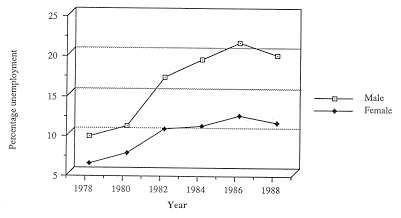 However, the evidence described in the previous section did not lend much support to this idea (Cormack and Osborne, 1985). This section will examine the research evidence on unemployment in more detail. There is a lot of research on unemployment in Northern Ireland before the 1980s (for example, Salt and Johnson, 1975; Osborne, 1978; Morrissey, O'Connor and Tipping, 1984) but this section will deal primarily with work on the contemporary situation, largely because of the large increase in unemployment in this period. The first Part will examine the pattern of unemployment in Northern Ireland both externally (in comparison with levels in Scotland, and England and Wales) and internally (within Northern Ireland), and will then go on to describe some evidence on the social characteristics of the unemployed.
For the purposes of this review, the most important part of the
research evidence concerns that on the impact of unemployment
on the two communities in Northern Ireland: the evidence on this
will be examined in the final part of the section. A variety of
explanations have been offered to account for the differential
impact of unemployment on Protestants and Catholics and section
nine of the review will examine research evidence on the merits
of these explanations. Comparative patterns of unemployment Figure 8.1 indicates the extent of the steep rise in unemployment in Northern Ireland in the 1980s, both for men and for women. These official figures suggest that the level of unemployment peaked towards the end of the decade, at which time unemployment began to decline (it should be noted that part of this slow-down and decline in unemployment levels may be related to changes in the method of counting the number of unemployed: cf. Morrissey et al, 1984 p42; McCullagh, 1986). This overall pattern of increase was shared by most regions of the United Kingdom during this period. However, as figures 8.2 and 8.3 indicate, the traditionally higher levels of unemployment in Northern Ireland was maintained during this period, in comparison with the rest of the United Kingdom.
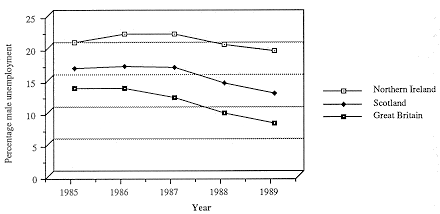 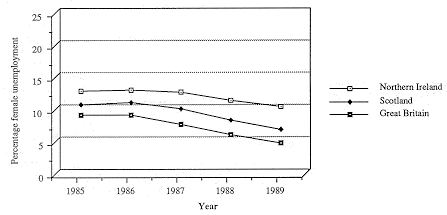
Thus, while the overall official level of unemployment in Northern
Ireland in 1989 (March 9) was 15.7%, the level for Scotland was
10.2% and the level for England and Wales was 6.6% (see Salt and
Johnson, 1975, and Doherty, 1981, 1982 for discussions on earlier
periods).
As Eversley (1989) has pointed out, unemployment is not uniform
throughout Northern Ireland but differs widely in different regions.
Figure 8.4 shows the percentage unemployment in each of the twelve
travel-to-work areas of Northern Ireland (in May, 1989) and indicates
a range from 11.3% in Ballymena to 29.3% in Strabane (Osborne,
1978, and Doherty, 1982 examined distributions in the 1970s).
The figures reinforce the pattern described in section 6, ie that
the Western and Southern parts of Northern Ireland tend to have
higher percentage levels of unemployment in comparison with the
Eastern part of the province.
(percentage of men and women, 1989) 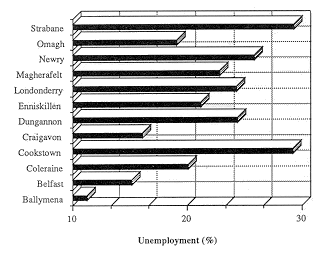
Percentages do not give a full picture of the spread of unemployment
in Northern Ireland because of the higher population concentration
in the East, particularly around Belfast. Figure 8.5 illustrates
this by showing the actual number of unemployed persons in each
of the travel-to-work areas. It can be seen from this figure that
the largest concentration of unemployed persons is in the Belfast
travel-to-work area: in fact, the 52,972 unemployed persons in
the Belfast area comprises almost half of the total number of
unemployed. By contrast the Strabane area, with the highest percentage
level of unemployment, contains only 3,310 unemployed persons.
(number of men and women, 1989) 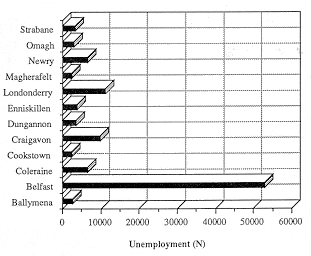
Just as unemployment is not evenly spread throughout Northern
Ireland, so it is not evenly spread through Belfast, the area
with the largest number of unemployed, persons (Doherty, 1981,
1982). Figure 8.6 compares the proportion of unemployed persons
in each of the four Westminster constituencies in Belfast, in
1989, with the proportion of the electorate in each constituency,
in 1987. Although there is a two year gap between these data,
they still provide a rough guide to the distribution of the unemployed
in Belfast. Figure 8.6 shows that the electorate in Belfast is
fairly evenly shared in each of the four constituencies, with
approximately a quarter of the total electorate in each area.
However, the distribution of the unemployed is disproportionately
lower in the Belfast South and, in particular, Belfast East constituencies
and disproportionately higher in the Belfast West constituency.
In Belfast North the proportion of the unemployed is roughly equal
to the proportion of the total Belfast electorate in that constituency.
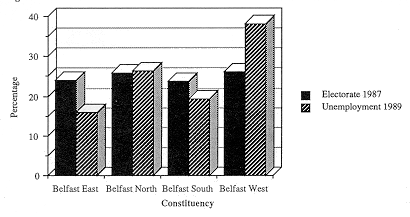
Patterns of unemployment in industrial sectors In addition to a geographical factor, unemployment levels differ among industrial sectors. Figure 8.7 compares the proportions of employed and unemployed men in each of the main sectors of employment. For example, 6% of the employed worked in agriculture, forestry or fishing, while 3% of the unemployed had worked in these industries. The most striking features of this figure relate to the manufacturing and construction industries. Thus, while 25% of employed men worked in manufacturing industry, only 12% of unemployed men had worked in manufacturing. By contrast, while 9% of employed men worked in construction, 23% of unemployed men had worked in construction. These patterns are somewhat exaggerated since the employed proportions are based on data for June, 1988, while the unemployed proportions are based on data for December, 1988: clearly, unemployment in the construction industry is likely to be greatest in the Winter months. Nevertheless, the figure does indicate the uneven spread of unemployment across industrial sectors.
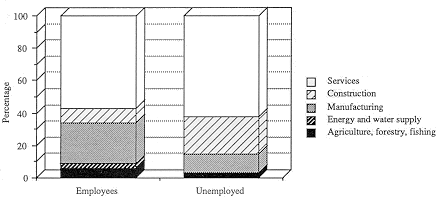 Age and duration of unemployment
In comparison with the whole of the United Kingdom, the unemployed
in Northern Ireland tend to be younger, particularly for men,
and to have been unemployed for longer periods. Figures 8.8 and
8.9 show the percentages of the unemployed in three age groups
(18 to 24 years, 25 to 49 years, 50 years and older) for Northern
Ireland and for the United Kingdom. Figure 8.8 shows the breakdown
for men and figure 8.9 shows that for women. All these data refer
to unemployment in January, 1998. Figure 8.8 shows that while
23% of unemployed men in the UK were aged 50 years or over, this
was true for only 14% of unemployed men in Northern Ireland. Similarly,
among women 16% of the unemployed in the UK fell into this age
group compared with 12% of those in Northern Ireland.
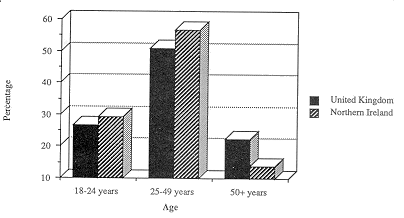
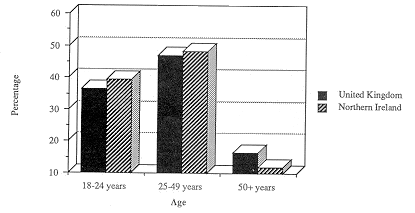
Figures 8.10 and 8.11 present similar data broken down by the
duration of unemployment: against the percentages are grouped
into three categories, those unemployed for less than 26 weeks,
those unemployed for between 26 weeks and 52 weeks, and those
unemployed for more than 52 weeks. Overall men tend to be unemployed
for longer periods compared with women, and this is true for both
the UK and for Northern Ireland. However, the instance of long-term
unemployment appears to be more acute in Northern Ireland, with
58% of unemployed men being without employment for more than a
year; by contrast, 45% of unemployed men in the UK were out of
work for more than a year.
United Kingdom vs. Northern Ireland 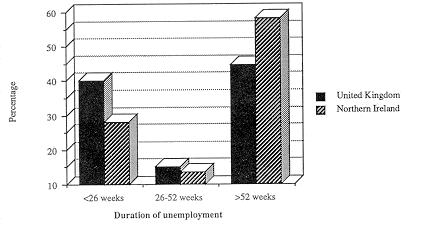
United Kingdom vs. Northern Ireland 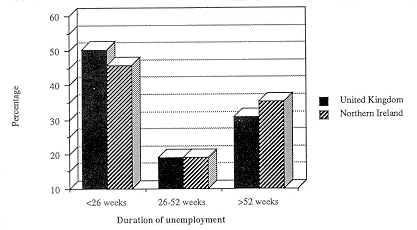
Further social characteristics of the unemployed In a survey of the unemployed in Belfast in 1972 Doherty (1981) found that the average age was 37 years and the average duration of unemployment was 45.2 weeks: the age distribution was skewed towards younger age groups. Doherty also found that men formed proportionately more of the unemployed than women, although this can be explained by the higher level of male participation in the workforce and the greater extent of unemployed women who do not register, and that the unemployed were most likely to be drawn from manual workers, particularly the unskilled. Although the data collected did not include the religion of individuals, Doherty noted that unemployment was positively correlated with religion such that the unemployed were more likely to be found in Catholic areas.
Miller and Osborne (1983) reported some findings from a survey
of a sample of unemployed men in 1976 drawn from all parts of
Northern Ireland. The main concern of Miller and Osborne's paper
concerned Protestant/Catholic differences among the unemployed
and these data will be discussed in the next section. For the
present it is worth noting that the mean age of the unemployed
was, at 31 years, somewhat lower than that found by Doherty and
that the overwhelming majority of the sample had no educational
qualifications. Miller and Osborne found somewhat more semi-skilled
and skilled manual workers among the unemployed, in comparison
with Doherty's findings, although this might be explained by sampling
differences in the studies. In addition, Miller and Osborne found
that Catholics were over-represented among the unemployed, in
comparison to their proportion in the population. RELIGION AND UNEMPLOYMENT This latter finding on the link between religion and unemployment forms the final part of this section. Evidence on the extent of unemployment among Protestants and Catholics will be presented here to illustrate the 'unemployment gap' that exists between the two communities. The various explanations that have been offered to account for this gap will be examined in the next section.
Figures 8.12 and 8.13 provide the basic information on unemployment
levels within the two communities for men and women respectively.
The data for 1971 and 1981 were derived from the censuses of those
years, while the data for 1983/4 and 1985/7 were derived from
the Continuous Household Survey (Osborne and Cormack, 1986; PPRU,
1989.
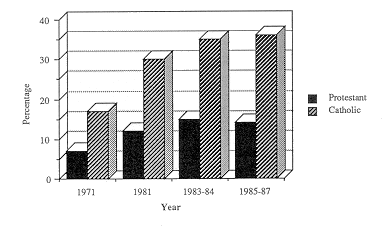
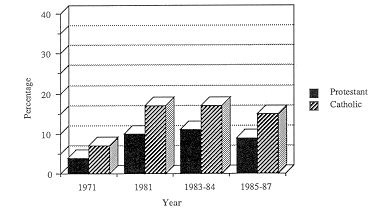
The figures show that, in 1971, Catholic men were 2.6 times as
likely to be unemployed as Protestant men, while Catholic women
were 1.9 times as likely to be unemployed as Protestant women.
For both men and women this unemployment gap reduced slightly
in 1981 and 1983/4. In 1985/7 the unemployment gap for men had
returned to the 1971 level, while the gap for women had increased
again, but remained a little below the 1971 level.
These data highlight a number of points. They suggest that the
large increase in unemployment in the 1980s did not lead to a
reduction in the unemployment gap between the two communities,
either for men or for women. This in turn might appear to suggest
that the Fair Employment Act had rather limited success in promoting
fair employment practices in Northern Ireland. In addition two
inter-related questions are raised: why did the unemployment gap
exist and why did it persist? The evidence on some of the suggested
answers will be examined in the next section.
NOTES
Data for figure 8.1: Unemployment in Northern Ireland by gender
and year (percentages)
Data for figure 8.2: Male unemployment by region, 1985-89 (percentages)
Data for figure 8.3: Female unemployment by region, 1985-89
(percentages)
Data for figure 8.4: Male and female unemployment by travel-to-work
areas, 9/3/89 (percentages)
Data for figure 8.5: Male and female unemployment by travel-to-work
areas, 9/3/89 (numbers)
Data for figure 8.6: Electorate and unemployment in the four
Westminster constituencies in Belfast (percentages)
Data for figure 8.7: Employees (June, 1988) and unemployed
(December, 1988) by industrial sectors, males only (percentages)
Data for figure 8.8: Age of the unemployed, United Kingdom
,and Northern Ireland, males only (percentage)
Data for figure 8.9: Age of the unemployed, United Kingdom
and Northern Ireland, females only (percentage)
Data for figure 8.10: Duration of unemployment, United Kingdom
and Northern Ireland, males only (percentages)
Data for figure 8.11: Duration of unemployment, United Kingdom
and Northern Ireland, females only (percentages)
Data for figure 8.12: Unemployment by religious affiliation
and year, males only (percentages)
Data for figure 8.13: Unemployment by religious affiliation
and year, females only (percentages)
| ||||||||||||||||||||||||||||||||||||||||||||||||||||||||||||||||||||||||||||||||||||||||||||||||||||||||||||||||||||||||||||||||||||||||||||||||||||||||||||||||||||||||||||||||||||||||||||||||||||||||||||||||||||||||||||||||||||||||||||||||||||||||||||||||||||||||||||||